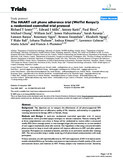| dc.description.abstract | The objectives are to compare the effectiveness of cell phone-supported SMS
messaging to standard care on adherence, quality of life, retention, and mortality in a population
receiving antiretroviral therapy (ART) in Nairobi, Kenya.
A multi-site randomized controlled open-label trial. A central
randomization centre provided opaque envelopes to allocate treatments. Patients initiating ART
at three comprehensive care clinics in Kenya will be randomized to receive either a structured
weekly SMS (’short message system’ or text message) slogan (the intervention) or current standard
of care support mechanisms alone (the control). Our hypothesis is that using a structured mobile
phone protocol to keep in touch with patients will improve adherence to ART and other patient
outcomes. Participants are evaluated at baseline, and then at six and twelve months after initiating
ART. The care providers keep a weekly study log of all phone based communications with study
participants.
Primary outcomes are self-reported adherence to ART and suppression of HIV viral load at twelve
months scheduled follow-up. Secondary outcomes are improvements in health, quality of life, social
and economic factors, and retention on ART. Primary analysis is by ‘intention-to-treat’. Sensitivity
analysis will be used to assess per-protocol effects. Analysis of covariates will be undertaken to
determine factors that contribute or deter from expected and determined outcomes.
This study protocol tests whether a novel structured mobile phone intervention can
positively contribute to ART management in a resource-limited setting. | en |

